Macclesfield Union, Cheshire
Up to 1834
Macclesfield had a workhouse from 1698, probably near the Market Place and later moved to Town's Yard, at the corner of Buxton Road and Commercial Road.
A parliamentary report of 1777 recorded local workhouses in operation at Adlington (for up to 42 inmates), Bollington (18), Chorley (80), Gawsworth (28), Pott Shrigley (20), Macclesfield (160), Rode (6), Sutton (20), and Rainow (30).
The Rainow parish workhouse consisted of two cottages on Tower Hill.
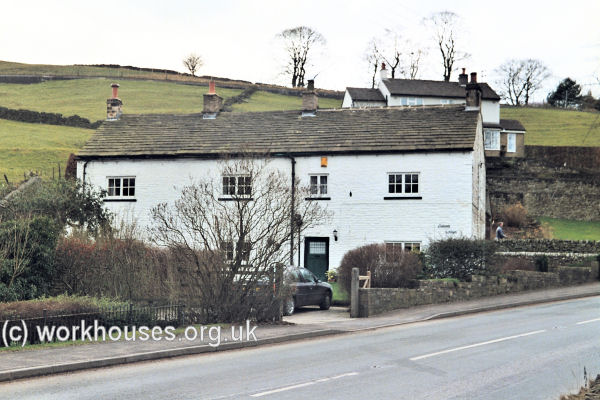
Former Rainow parish workhouse, 2005.
© Peter Higginbotham
Sutton's workhouse was opened in 1785 on Walker Lane, Sutton.
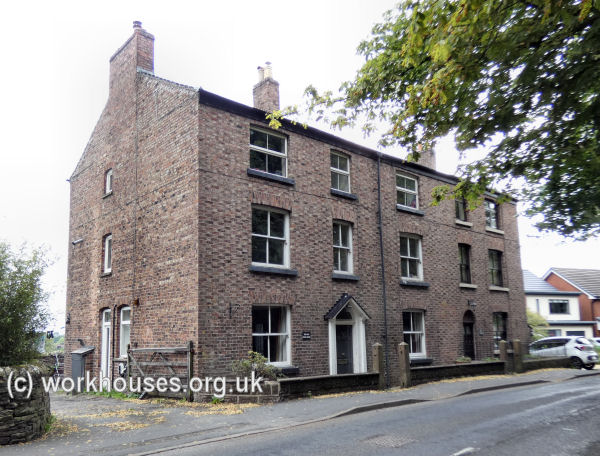
Former Sutton parish workhouse, 2020.
© Peter Higginbotham
In 1819, charges were brought against the Macclesfield workhouse Master, Charles Salt, at the annual Vestry meeting. It was alleged that he was blasphemous, had stolen from an old woman, kept ducks there which he had fed on the inmates' bread, and was regularly inebriated. He was however acquitted.
After 1834
The Macclesfield Poor Law Union formally came into being on 26th September 1836. Its operation was overseen by an elected Board of Guardians, 50 in number, representing its 41 constituent parishes as listed below (figures in brackets indicate numbers of Guardians if more than one):
County of Chester:
Macclesfield Town (7), Macclesfield Forest, Adlington, Alderley Inferior, Alderley Superior, Birtles, Bollington (2), Bosley, Butteley, Capesthorne, Chelford, Chorley, Eaton, Fallybroom, Gawsworth, Henbury with Pexhall, Hurdsfield (2), Kettleshulme, Lyme Handley, Marton, Motram St Andrews, Newton, Poynton, Pott-Shrigley, Prestbury, Rainow, North Rode, Siddington, Snelson, Sutton (2), Taxal, Tytherington, Upton, Whaley-cum-Yeardsley, Wildboar-Clough, Wincell, Lower Withington, Old Withington, Woodford, Worth.
Later additions: Alderley Edge (1894-1930), Kerridge (1894-1900).
The population falling within the Union at the 1831 census had been 50,639 — ranging from Fallybroom (population 25) to Macclesfield Town (23,129). The average annual poor-rate expenditure for the period 1833-35 had been £11,534 or 4s.7d. per head.
Soon after the union's formation, the Macclesfield Guardians decided to erect a new union workhouse. An architect was appointed, and plans approved for a design based on the Poor Law Commissioners' model 'square' layout. The workhouse, intended to accommodate 580 inmates, was estimated to cost in the region of £5,000. However, there was intense local opposition to the new workhouse, particularly from workers in the town's declining silk weaving industry. Although a local builder tendered for the work, he was subjected to such abuse and intimidation that the plan had to be shelved. Instead, the union continued to use the existing workhouse at Waters-green for able-bodied paupers, with Sutton being used for children, and Rainow for old men and women.
In 1842, Chairman of the Guardians, Mr Thomas Itchenor Watts, again proposed that a new workhouse be built. Of the existing Macclesfield building he said:
In December 1842, the old workhouse had become so overcrowded that scenes of violence were not uncommon. The official capacity was 220 inmates, but often reached a hundred more than that. On 10th January, 1843, the Board of Guardians passed a resolution to build a new Workhouse at a cost of £5,000. A site had already been found on Prestbury Road for which the freehold was purchased. The partnership of Scott and Moffatt provided plans for the new building which was their only workhouse in Cheshire. A tender was accepted from James Frost, a local builder, for £8,955 comprising: the main building (£5,965), hospital (£1,500), Board Room and Tramp Room (£1,290); drainage (£200), lodge (£35). The new building was finished early in 1845, although extra work resulted in an additional £1,800 to the builder. The workhouse's location and layout are shown on the Ordnance Survey map of 1907:
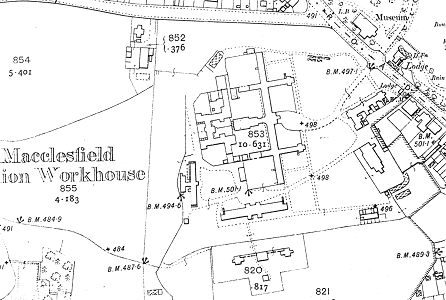
Macclesfield site, 1907.
At the east of the site was a small porter's lodge, behind which stood an L-shaped receiving block which contained porter's quarters, male and female vagrants' wards, board room, clerk's room and a stable.
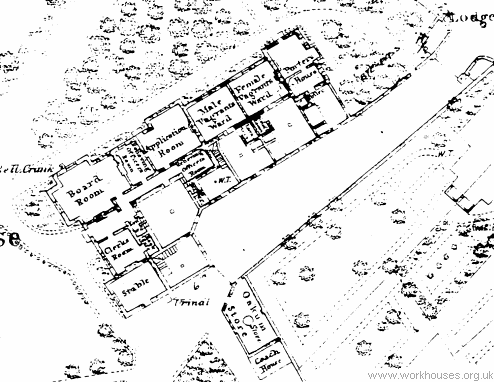
Macclesfield board-room block, 1871.
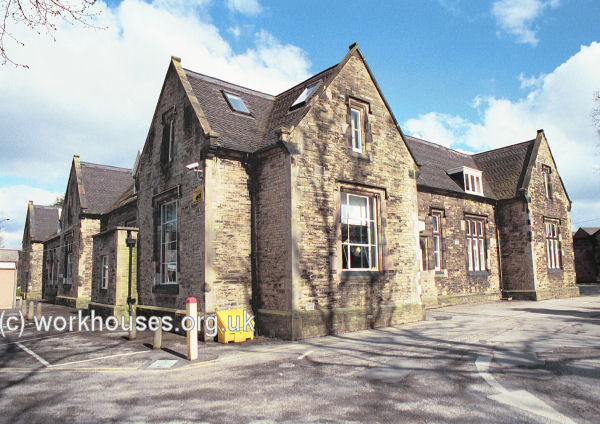
Macclesfield receiving block from the west, 2001.
© Peter Higginbotham
The main building, which faced to the east, had a three-storey central block set between pairs of cruciform two-storey wings.
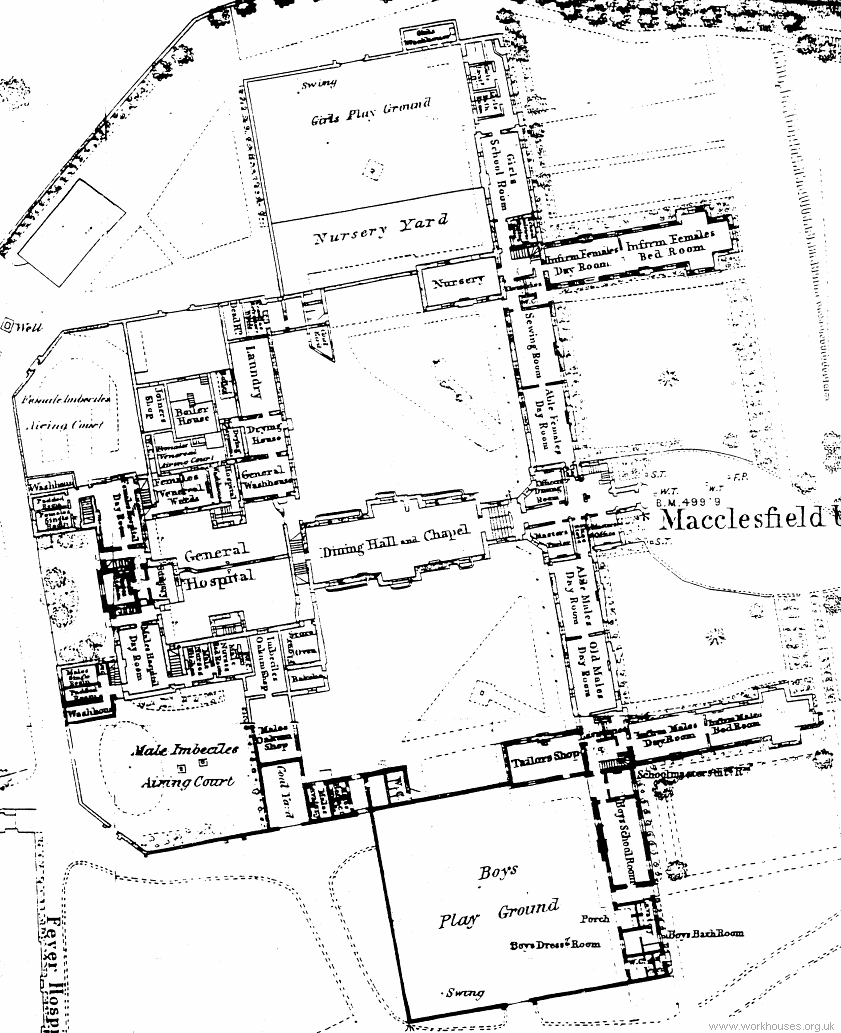
Macclesfield workhouse main block, 1871.
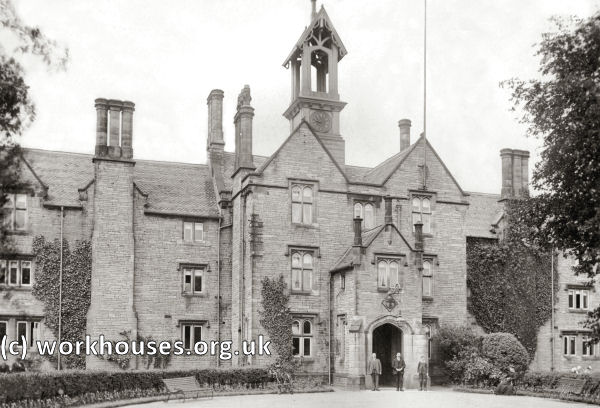
Macclesfield workhouse main building from the east, early 1900s.
© Peter Higginbotham
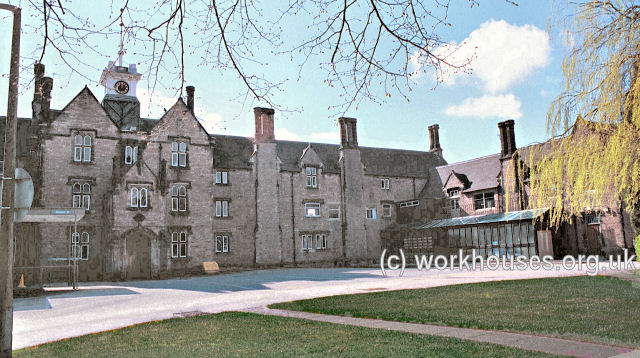
Macclesfield workhouse main building from the east, 2001.
© Peter Higginbotham
The front door was surmounted by a date stone bearing the inscription ERECTED AD 1843.
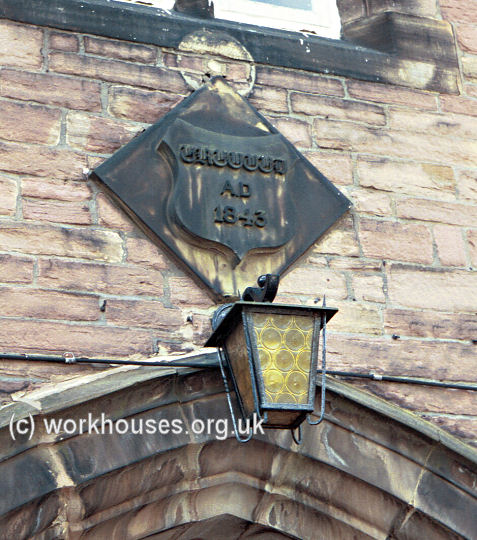
Macclesfield workhouse date stone from the east, 2001.
© Peter Higginbotham
To the rear of the main block, a supervision hub connected to the dining hall which was also used as a chapel. The interior was decorated with frescoes containing the Decalogue, the Apostles' Creed, and the Lord's Prayer, the work of a pauper. There were also framed woodcuts and oleographs from illustrated newspapers.
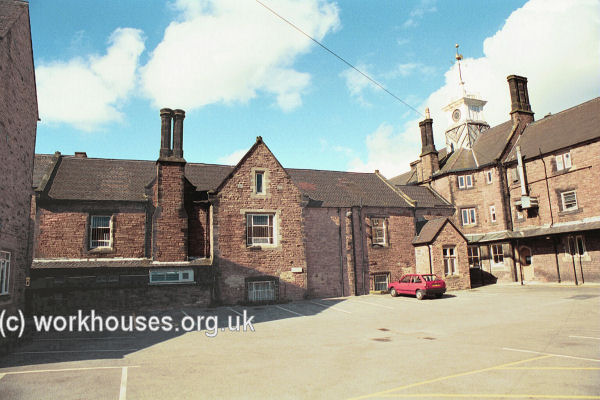
Macclesfield workhouse dining hall and rear of main block from south-west, 2001.
© Peter Higginbotham
Immediately to the south-west of the dining hall stood workshops used for oakum picking.
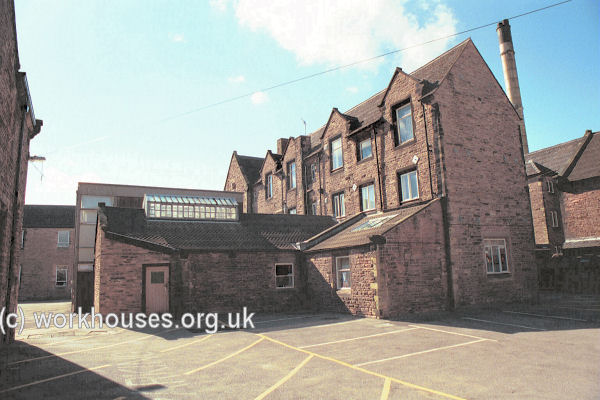
Macclesfield workhouse oakum workshops from the south-east, 2001.
© Peter Higginbotham
To the rear of the workhouse was a three-storey hospital block, the north of which accommodated females, and the south males.
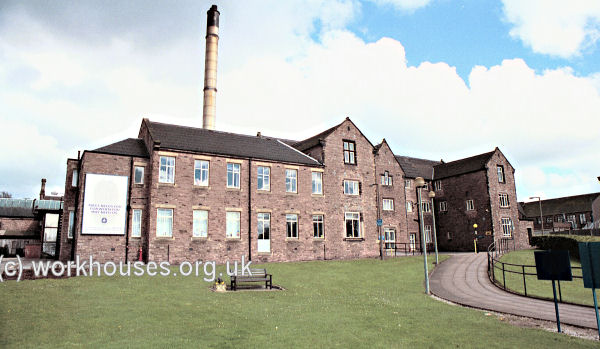
Macclesfield workhouse hospital block from the west, 2001.
© Peter Higginbotham
Later additions to the site included a 60-bed fever hospital to the south-west of the workhouse, built in 1853-4 at a cost of around £1,200, a new 70-bed hospital block to the south of the workhouse in 1879-81 costing about £6,000, and a nurses' home, located between these two hospitals, in 1912-13..
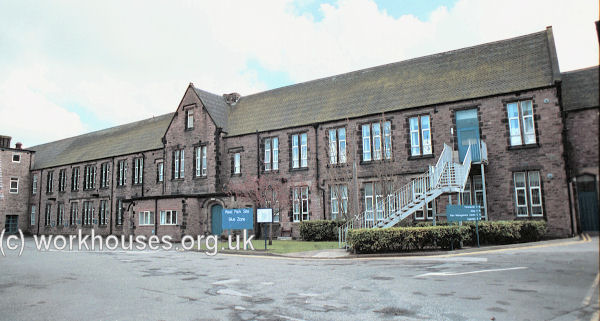
Macclesfield workhouse 1881 hospital block from the west, 2001.
© Peter Higginbotham
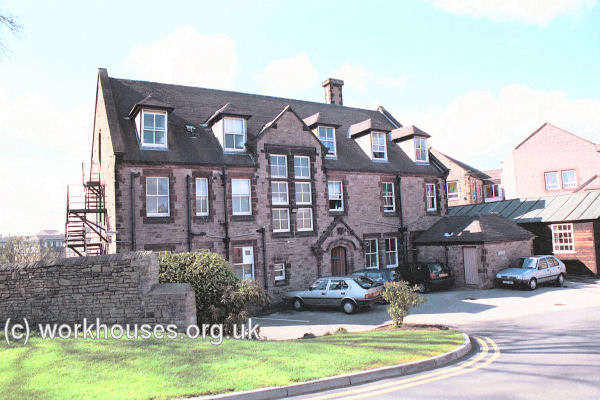
Macclesfield workhouse nurses' home, 2001.
© Peter Higginbotham
According to A Walk Through the Public Institutions of Macclesfield the inmate population at the time of its visit in 1888 numbered 346. This figure included 79 old women and 90 old men. Amongst the able-bodied females were 21 washers, 22 sewers and knitters, 12 scrubbers, 12 assisting women, 4 in the kitchen, 4 in the nursery, and 4 stocking darners. On the men's side were 2 joiners, 1 slater, 1 upholsterer, 1 blacksmith, 3 assisting the porter with the tramps, 6 men attending the boilers, 3 attending the stoneshed men, 4 whitewashers, 4 attending the pigs, 2 looking after sanitary matters, 1 regulating the coal supply, 18 potato peelers, 1 messenger, 26 ward men, 2 doorkeepers. There were 12 boys at work in the tailor's shop.
From the 1890s, Macclesfield operated a liberal regime for its elderly workhouse inmates as this 1895 report illustrates:
These wards are as near an approach to home as it is possible to get. The furniture is complete and comfortable, and the decorations bright and cheerful. The inmates are permitted to retain odd articles of their own, and no objection is made to the old lady bringing her cat or the old man keeping his bird. They must take care, though, that their pets do not prove a source of annoyance to their fellow-inmates, otherwise they are banished. The old people may raise flowers, too, for the decoration of their rooms, and they have the pick of everything that comes into the workhouse in the way of books and newspapers.
All the inmates live quite select, and have no intercourse with the other side of the workhouse. Their meals are all served to them in their own wards, and consist of food of a better quality than that which is provided for the able-bodied paupers in the other wards. They may take a little rest, if they choose, after their dinners; and then, at three o'clock, tea, quite a cosy little repast, is sent to them, to the keen delight, of course, of the old women. They go in and out of the union by their own private door, and one part of the grounds is reserved for them to walk in. Not that they need spend their time there unless they choose, for they are free to take their walks abroad every afternoon — to saunter about in the town listening to the news of the day, or to hunt up old friends. And old friends are less prone to fight shy of them now than they used to be in the days when they must all bear the workhouse badge. There is no longer any touch of the pauper in the appearance of these old folk; they have no uniform, but wear the same sort of clothes as members of the artisan class; and they look exactly what they are — respectable old men and women whose working days are over. An arrangement is in force for the special benefit of those who are lacking either in the strength or the inclination to go out in search of friends. From three to four o'clock every afternoon, excepting Sunday, all who wish may hold an "at home" their wards, and may receive there whoever cares to come to see them.
After 1930, the site became Macclesfield Public Assistance Institution, run by Cheshire County Council, with the medical facilities operating as West Park Hospital from 1933. During the Second World War, the hospital was used for the treatment of military casualties. With the launch of the National Health Service in 1948, the site became the West Park branch of Macclesfield Hospital. The Hospital's use of the old buildings ended in 2008. The main surviving portions are the boardroom block (now converted to a nursery), the main black (now residential use) and the 1881 hospital block (now a care home).
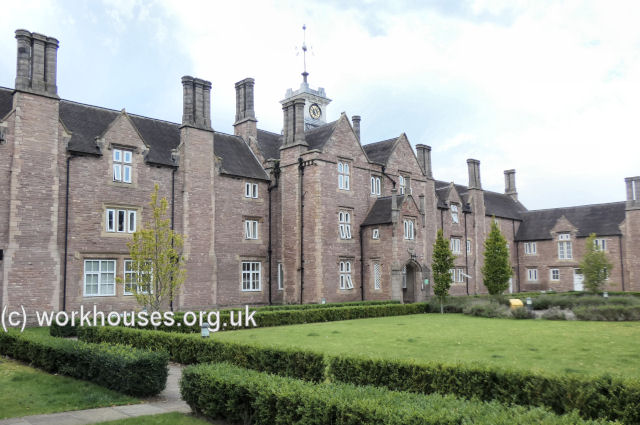
Macclesfield main building from the south-east, 2020.
© Peter Higginbotham
Scattered Homes
From around 1912, the union operated scattered homes for boys at Holm Lea, Chester Road, Macclesfield, and for girls at Ash Mount, Peter Street, Macclesfield.
Staff
Inmates
Records
Note: many repositories impose a closure period of up to 100 years for records identifying individuals. Before travelling a long distance, always check that the records you want to consult will be available.
- Cheshire Archives and Local Studies, Cheshire Record Office, Duke Street, Chester, Cheshire CH1 1RL. Holdings include: Admissions and discharges (1863-1940); Children's admissions and discharges (1913-33); Military patients admissions and discharges (1914-25); Births (1848-65); Baptisms (1898-1930); Deaths (1848-1949); Creed register (1885-90; 1902-23); Punishment book (1849-1912); etc.
Bibliography
- A Walk Through the Public Institutions of Macclesfield (Macclesfield Courier and Herald, 1888)
- Macclesfield Workhouse edited by Patricia Brigg (Graveyard Press, 1999)
Links
- None.
Unless otherwise indicated, this page () is copyright Peter Higginbotham. Contents may not be reproduced without permission.


